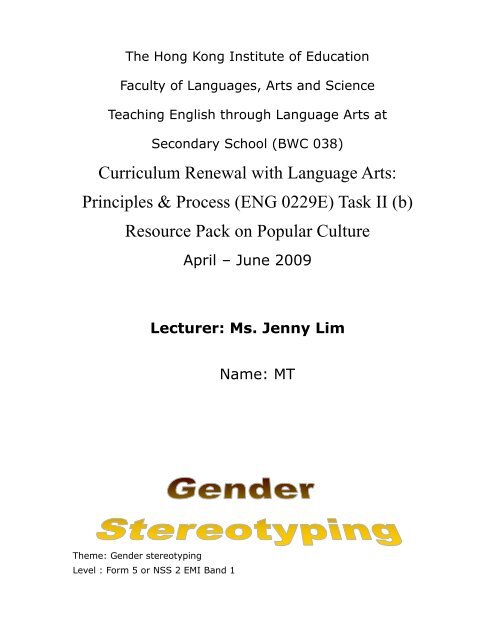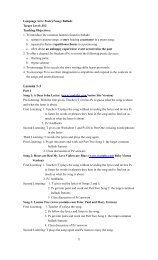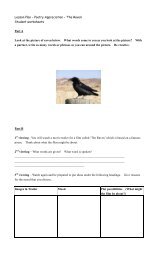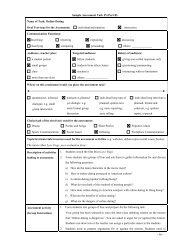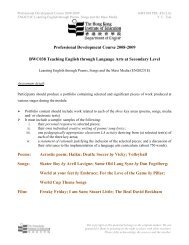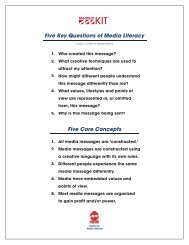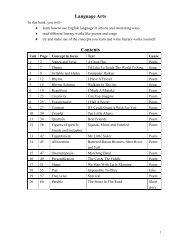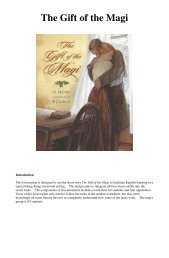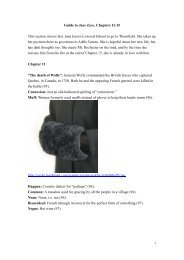Lecturer: Ms. Jenny Lim - English Department - Resources - The ...
Lecturer: Ms. Jenny Lim - English Department - Resources - The ...
Lecturer: Ms. Jenny Lim - English Department - Resources - The ...
You also want an ePaper? Increase the reach of your titles
YUMPU automatically turns print PDFs into web optimized ePapers that Google loves.
<strong>The</strong> Hong Kong Institute of Education<br />
Faculty of Languages, Arts and Science<br />
Teaching <strong>English</strong> through Language Arts at<br />
Secondary School (BWC 038)<br />
Curriculum Renewal with Language Arts:<br />
Principles & Process (ENG 0229E) Task II (b)<br />
Resource Pack on Popular Culture<br />
<strong>The</strong>me: Gender stereotyping<br />
April – June 2009<br />
<strong>Lecturer</strong>: <strong>Ms</strong>. <strong>Jenny</strong> <strong>Lim</strong><br />
Level : Form 5 or NSS 2 EMI Band 1<br />
Name: MT
Summery sheet of text types<br />
Part Activities Teaching resources Duration<br />
A Photos and comic<br />
B TV<br />
strips analysis –<br />
photo captions &<br />
essay<br />
commercials –<br />
slogan writing &<br />
oral presentation<br />
C Films analysis –<br />
Objectives:<br />
advice column &<br />
interview<br />
Photos from the web<br />
Source:<br />
http://www.cartoonstock.com/direc<br />
tory/g/gender_role.asp<br />
http://www.tellyads.com/show_mov<br />
ie.php?filename=TA5773<br />
http://www.youtube.com/watch?v=<br />
vHLnC7dZoVY&feature=PlayList&p=<br />
985DDAFBAD271BCD&index=0<br />
Billy Elliot & Bend it like Beckham<br />
Trailer:<br />
http://www.youtube.com/watch?v=<br />
JoiVEyCosEE&feature=fvst<br />
By the end of the lessons, students will be able to:<br />
1<br />
8 lessons<br />
5 lessons<br />
8 lessons<br />
� be aware how culture or mass media shape the gender differences<br />
� be critical about what messages they receive from the media<br />
� think critically and understand themselves<br />
� express themselves freely in <strong>English</strong><br />
� understand, interpret ideas, information, opinions and intentions<br />
presented in various text types<br />
� develop the vocabulary, language, format and styles used in different<br />
text types<br />
� apply the knowledge and skills they have learnt in their creative<br />
production and appreciation of popular culture texts
Part A Photo Analysis<br />
Discuss in groups of 4, who is the target group to buy the toys in the photos.<br />
A.<br />
B.<br />
2
What toys did you play when you were small?<br />
What kinds of toys do you think girls / boys play?<br />
Girls’ toys:<br />
Boys’ toys:<br />
Is there a difference? Why?<br />
Work with your partner. Write down a list of adjectives that you will use for boys<br />
and girls.<br />
Adjectives describing boys Adjectives describing girls<br />
3
Vocabulary building<br />
Read the list of words below. Put an “F” next to those that describe females and<br />
an “M” next to those that describe males. “B” for both.<br />
adventurous aggressive charming ambitious bossy blunt<br />
brave muscular competitive cool considerate handsome<br />
clever cute dainty decisive dependent domineering<br />
charismatic emotional giggly gossipy graceful heroic<br />
independent lovely nagging passive practical troublesome<br />
romantic sentimental sexy sensitive soft strong<br />
submissive supportive sweet talkative tender timid<br />
tough tranquil rebellious imaginative athletic unemotional<br />
objective analytical logical rational trustworthy docile<br />
violent hostile introverted extroverted slim sensible<br />
4
Question for Thought:<br />
Why do we use some adjectives for boys and some others for girls?<br />
Have we created a stereotype for different gender? Try to think of some<br />
examples of gender stereotypes and discuss with the class.<br />
Male Female<br />
e.g. Men don’t cry.<br />
5<br />
e.g. A good housewife<br />
needs to cook well.
1.<br />
2.<br />
“No, this is not Mel’s secretary. This is Mel.”<br />
6
Read the two comic strips and discuss with your partner. Is there a gender<br />
stereotype in the two comic strips?<br />
Work in pairs.<br />
Create the dialogue and the thought bubble for the characters.<br />
Source: http://www.cartoonstock.com/directory/g/gender_role.asp<br />
7
Portrayal of gender in print media<br />
Photo A Caption:____________________<br />
Photo B Caption:________________<br />
8
Photo C Caption: ______________________<br />
Photo D<br />
Caption: ________________<br />
Photo E<br />
Caption: _________________<br />
9
Writing Photo captions and essay<br />
Form groups of 4, collect 5-10 magazine advertisements/covers/photos which<br />
are about gender roles and stereotypes.<br />
1. Write a photo caption for each of the photos. (Each student needs to write 4<br />
captions individually)<br />
2. Give feedback on each others’ captions. Revise them if necessary.<br />
3. Write one or two paragraphs on the collection of photos.<br />
4. Present the photos and captions on a poster.<br />
5. Give an oral presentation of the collection of photos in class, explaining how<br />
these photos give us insights into gender roles and stereotypes. Classmates<br />
give oral feedback.<br />
6. Post up the posters in class. Classmates give written feedback if they wish.<br />
Photo Caption – a sentence that answers some of the questions below.<br />
An additional sentence may be added to give more details if needed.<br />
Who is being captured in the photo?<br />
What is he/she doing?<br />
Where was the photo taken?<br />
When was the photo taken?<br />
Why was the photo taken?<br />
Photo Essay – a story told in photos with some statements<br />
Write one or two paragraphs for the collection of photos, addressing these<br />
issues:<br />
- What gender characteristics are portrayed in the photos?<br />
- What is the story or message conveyed in the photos?<br />
(References: South China Morning Post Photo Essay<br />
http://www.time.com/time/photoessays)<br />
10
Language and structures<br />
1. Present tense and active verbs are used<br />
e.g. Pretty and sexy girls appear in one of the most popular women’s<br />
magazines, defining the concept of modern beauty. (Photo A)<br />
e.g. Christy Chung poses for her latest slimming advertisement. (Photo B)<br />
2. Adverbial clauses are used to define or provide details of the subject.<br />
e.g. A young executive, showing a big grin on her cheerful face, is heading<br />
success in career. (Photo D)<br />
e.g. A model, selling beauty products, is asking customers to go green. (Photo<br />
E)<br />
Rubrics for photo captions and essay are adapted from:<br />
http://www.pbs.org/wnet/americanmasters/education/lesson27_organizer3.h<br />
tml<br />
11
Rubrics for photo captions<br />
Requirements Points<br />
Available<br />
Does the presentation have a minimum of 5<br />
photographs?<br />
Do the photographs demonstrate a variety<br />
of images and perspectives?<br />
Can the captions describe accurately the<br />
photographs?<br />
Are all of the photographs mounted on a<br />
poster in a logical and aesthetic manner?<br />
Do the photographs follow a central theme? 10<br />
Essay<br />
12<br />
5<br />
20<br />
20<br />
Requirements Points<br />
Available<br />
Effective narrative in telling the story of the<br />
event, concept, issue represented by the<br />
photographs<br />
Accurate grammar and spelling 10<br />
Does the paragraph fully explain the choice<br />
of the photos in the collection?<br />
Total: _____________<br />
5<br />
20<br />
10<br />
Points<br />
Earned<br />
Points<br />
Earned
I. Ideas & Organization<br />
Feedback form for group presentation<br />
1. Can convey relevant ideas clearly and<br />
fluently<br />
2. Can elaborate in detail<br />
3. Can link main points with support<br />
II. Communication Strategies<br />
1. Can use appropriate body language to<br />
engage interest<br />
2. Can judge timing to cover all essential<br />
points<br />
III. Language & Vocabulary<br />
1. Can use accurate language patterns<br />
2. Can use a wide range of appropriate<br />
vocabulary<br />
IV. Pronunciation & Delivery<br />
1. Can project the voice appropriately<br />
2. Can pronounce words clearly and<br />
accurately<br />
3. Can speak fluently and naturally<br />
Excellent Good Fairly<br />
13<br />
good<br />
Needs<br />
(Adapted from SBA Assessment Criteria for Individual Presentation)<br />
improvement
Part B TV commercials<br />
Watch the two TV commercials and write down what you see.<br />
http://www.tellyads.com/show_movie.php?filename=TA5773<br />
http://www.youtube.com/watch?v=vHLnC7dZoVY&feature=PlayList&p=985D<br />
DAFBAD271BCD&index=0<br />
What kind of gender symbols do the TV commercials try to convey?<br />
14
Can you think of other examples? Discuss that in groups of 4.<br />
Watch these two TV commercials.<br />
Gillette M3 Power<br />
http://www.youtube.com/watch?v=UFYWtGO3Fkw<br />
Lancome Magnifique<br />
http://www.youtube.com/watch?v=qPvqUxlQPaw<br />
15
What advertising techniques have been used?<br />
Work in groups 4, think of a product and create an advertisement for it.<br />
Add a slogan. Your presentation is about three minutes.<br />
Additional information for reference:<br />
Source: http://www.epromos.com/educationCenter/qus11.jsp<br />
34 Ways to Write a Slogan<br />
1. Ask a question<br />
Does she or doesn't she? -Clairol<br />
2. Show your unique commitment<br />
We try harder -Avis<br />
3. Explain product superiority<br />
Takes a licking and keeps on ticking -Timex<br />
4. Evoke a benefit in a fresh way<br />
Let your fingers do the walking -Yellow Pages<br />
5. Use an emotive call to action<br />
Reach out and touch someone -AT&T<br />
6. Use an evocative call to action<br />
Put a tiger in your tank -Esso<br />
7. Use an imperative call to action<br />
Just do it -Nike<br />
8. Use a one-word call to action<br />
Think -IBM<br />
16
9. Use a cheeky call to action<br />
Let us tan your hide -Crisby Frisian Fur Co.<br />
10. Revisit a familiar call to action<br />
Reach out and bust someone -Crime Stoppers<br />
11. Link a product feature with an abstract need<br />
A diamond is forever -DeBeers<br />
12. Link a feature with your address<br />
We corner the market -Irving Rivers Ltd.<br />
13. Combine a feature and a benefit in the same phrase<br />
Make yourself at home -IKEA<br />
14. Declare a superlative feature<br />
<strong>The</strong> world's #1 selling financial software -Quicken<br />
15. Make a compelling promise<br />
<strong>The</strong> world on time -Federal Express<br />
16. Be whimsical<br />
It's the real thing -Coca-Cola<br />
17. Say it staccato<br />
Soothes. Cleanses. Refreshes. -Murine eyedrops<br />
18. Use a two-fold delivery with a twist<br />
Common sense. Uncommon results -David Ingram and Associates<br />
19. Address a specific need<br />
For women whose eyes are older than they are -Robert Powers skin cream<br />
20. Be abstract but client-centered<br />
After all, it is your information -Authentex Software<br />
17
21. Describe your product in a novel way<br />
Liquid jewelry -Lorr Laboratories nail polish<br />
22. Link company name to product benefit<br />
Never forgets -Elephant Memory Systems<br />
23. Suggest the cost of not using your product<br />
Because so much is riding on your tires -Michelin<br />
24. Be grotesque to make a point<br />
Wears like a pig's nose -W. M. Finck & Co. men's overalls<br />
25. Turn a current business maxim on its ear<br />
Think small -Volkswagen<br />
26. Link a well-known phrase with your product benefit<br />
Understanding comes with Time -Time magazine<br />
27. Brag about yourself<br />
We take the world's greatest pictures -Nikon<br />
28. Brag about your product and your client<br />
You and Betty Crocker can bake someone happy -Betty Crocker<br />
29. Take a breath and say it all<br />
Finest anti-knock non-premium gasoline ever offered at no extra cost -Union<br />
Oil Co.<br />
30. Describe your service and its #1 benefit in two words<br />
Advertising pays -Industry maxim<br />
31. Personify your product<br />
Laughs at time -Du Pont paint<br />
32. Distill your business into one phrase<br />
<strong>The</strong> Document Company -Xerox Corp.<br />
18
33. Tie your slogan to your logo<br />
Get a piece of the Rock -Prudential Insurance Co.<br />
34. Dare to be different<br />
Dare to diff -LOEB Cola<br />
Source: http://www.qualitylogoproducts.com/lib/how-to-write-a-slogan.htm#<br />
Another 34 Ways to Write a Slogan<br />
1.) Keep it Short<br />
Average slogan length is five words. Boil down the entire essence of the product or service into this<br />
prevailing statement.<br />
2.) Don’t Use the Brand Name<br />
Given the cost of advertising today, use the words of the slogan to make an impact<br />
3.) Use Simple Language<br />
High-tech industries know that the common individual will not understand all the technical terms.<br />
4.) Set the Tone<br />
Declarative structuring makes a statement: “A diamond is forever.” Interrogatives question the<br />
status quo. “Got milk?”<br />
5.) Command Attention<br />
Use imperative phrasing. This method commands or persuades buyers to patronize your brand.<br />
6.) State the Difference<br />
“Have it your way.” Burger King revolutionized the standard in fast food ordering, and caused<br />
competitors to follow suit.<br />
7.) Rethink Spelling<br />
Many famous companies utilize the particular letters in their corporate/brand name and purposely<br />
use those same letters throughout the phrase.<br />
8.) Improper Grammar<br />
“Don’t just book it, Thomas Cook it,” turned the cruise line name into a verb.<br />
9.) Rhetoric Sells<br />
Slogans use alliteration, metaphor, repetition, or some other type of word play.<br />
10.) Make-Up Your Own Words<br />
Inventing new words from others can set the phrase apart.<br />
19
11.) Verbal Impression<br />
When you only have a few words to make the statement, go out on a limb. Smarties used<br />
“WotalotIgot!”<br />
12.) Find a Unique Facet<br />
Make a list of the advantages of your product. Note the one or two things you have to offer over the<br />
competition and create a slogan that states it.<br />
13.) Think Green<br />
With environmental issues at the forefront, aim for a slogan that assures the consumer a purchase<br />
with low impact on the planet.<br />
14.) Target a Concern<br />
Focus on current concerns relevant to your product and use language that gets consumer attention.<br />
15.) State your Commitment<br />
Look at what the top 10 in your industry are rated for, and prove why your rating should be No. 1.<br />
16.) Identify Emotionally<br />
Whether funny or serious, eliciting an emotional response is important in soliciting customers.<br />
17.) Revisit Past Slogans<br />
Take an outdated, well-remembered phrase and change a word to apply to the specific product or<br />
service.<br />
18.) Paint a Word Picture<br />
Since the prevailing method of media now lies on the Internet, the trend has become “the picture” is<br />
worth a thousand words, and a slogan is the icing on the cake.<br />
19.) Link Your Logo<br />
Take the name(s) of the items/symbols in your logo and use those in the<br />
slogan or other logo products.<br />
20.) Use Anthropomorphism<br />
Apply human or animal characteristics to your product or service.<br />
21.) Tie Company Name to a Famous Saying<br />
Make the name match the goal or product offered.<br />
22.) Be Whimsical<br />
Try coming up with silly or amusing words to describe your company’s theme.<br />
20
23.) Consider the Competition<br />
Look at all your competitor ads and search for the one thing that is missing which you can offer the<br />
consumer.<br />
24.) Use Opposites<br />
If you offer a small product by comparison to competition, try, “Think small.”<br />
25.) Compare and Contrast<br />
Use this method to cite the risks of failing to use your product or service.<br />
26.) Break the Mold<br />
If competitor ads tend to state the same thing, take a fresh approach in finding the right words.<br />
27.) Promise Something<br />
When your product has something the others do not, such as an unconditional money-back<br />
guarantee, express that as the heart of the slogan.<br />
28.) Focus on the Consumer<br />
Coming at consumers with their best interest at heart goes farther than touting the company’s<br />
advantages.<br />
29.) Use Sex-Appeal<br />
Everything from cars to food uses this method of getting consumer attention. Try working it into your<br />
slogan.<br />
30.) Forget the Hype<br />
Hype is overblown claims, unsupported superlatives and is generally no longer believed.<br />
31.) Be Universal<br />
Consider the market in Japan or other countries and ensure you use ideas not only Americans<br />
understand.<br />
32.) Proof It<br />
If current or near-future trends can affect your sales, think about a slogan that will be successful in<br />
a slow economy.<br />
33.) Prove It<br />
Truthfully citing a million satisfied customers offers security in dealing with your company.<br />
34.) Test It<br />
Try your slogan out on co-workers, family, and friends. Going out on the streets to interview<br />
potential customers, gives information as to what consumers really think.<br />
21
Adapted from:<br />
http://www.tenafly.k12.nj.us/~wjaeger/grading_rubrics.htm#Slogan<br />
Slogan Rubric<br />
Category Excellent Average Below Average Total<br />
Content<br />
Visual<br />
Appearance<br />
Creative<br />
/Catchy<br />
Your slogan is an overarching<br />
idea or you choose the most<br />
important feature of your<br />
product to advertise.<br />
<strong>The</strong> slogan is displayed in a<br />
way that visually hooks the<br />
audience. <strong>The</strong> presentation is<br />
perfect (neat, clear and uses<br />
color to illuminate the view).<br />
Your slogan is written and<br />
worded in a creative way that<br />
hooks the audience.<br />
Your slogan<br />
captures a feature<br />
of your product.<br />
<strong>The</strong> slogan is<br />
displayed in a way<br />
that allows the<br />
audience to read the<br />
slogan. <strong>The</strong> words<br />
are easy to read.<br />
Your slogan is<br />
creative and written<br />
in a catchy way.<br />
22<br />
Your slogan does not<br />
capture a feature of<br />
your product.<br />
Your slogan is not<br />
easy to read on the<br />
poster board, there<br />
are few-no colors<br />
and does not catch<br />
the eye.<br />
Not very clever and<br />
creative when<br />
making your<br />
slogan. Your slogan<br />
is not catchy.<br />
Total Points:<br />
Points<br />
10<br />
5<br />
5
Group Presentation Rubric<br />
Category Excellent Average Below Average Total<br />
Content<br />
Communica<br />
tion Skills<br />
Enthusiasm<br />
/Tone<br />
You included content that<br />
highlights the most important<br />
features and details of your<br />
product. You conducted<br />
research outside of the<br />
textbook and handout<br />
materials.<br />
When doing your sales<br />
presentation you speak clearly,<br />
at a regular pace and you always<br />
have eye contact with your<br />
audience. Excellent speaking<br />
skills and the presentation is<br />
easy to follow.<br />
You are very spirited and<br />
energetic when giving your<br />
sales presentation. You always<br />
have a smile on your face and<br />
you have an upbeat voice. You<br />
generate a great deal of<br />
interest in your presentation.<br />
Persuasion You exemplify a true<br />
salesperson by using catchy<br />
words and sayings and you<br />
phrase the information in a<br />
convincing way. You state all<br />
of the information for your<br />
product positively. You take a<br />
negative trait and make it<br />
positive. Excellent job<br />
convincing others to settle in<br />
your product.<br />
23<br />
You include content that<br />
highlights features of<br />
your product and you<br />
include details.<br />
When doing your sales<br />
presentation the audience<br />
can follow your<br />
presentation and you have<br />
some eye contact with the<br />
audience. Good speaking<br />
skills.<br />
You generate interest<br />
when giving your sales<br />
presentation. Your voice<br />
is lively and you show<br />
expression in your face.<br />
When giving your sales<br />
presentation you use<br />
convincing words and<br />
phrases to help sell your<br />
product. Good job<br />
convincing others to<br />
settle in your product.<br />
You include content<br />
that does not highlight<br />
your product very well<br />
and you do not include<br />
much detail.<br />
<strong>The</strong> audience cannot<br />
follow what you are<br />
saying and either you<br />
are speaking quickly or<br />
slowly. Little-no eye<br />
contact with the<br />
audience.<br />
You do not show any<br />
interest in your sales<br />
presentation. Your<br />
voice is monotone and<br />
you do not have any<br />
facial expressions.<br />
You do not perform<br />
the sales presentation<br />
as a salesperson. You<br />
do not phrase the<br />
information in a<br />
catchy, convincing<br />
way. You do not<br />
explain to people why<br />
they should settle in<br />
your product.<br />
Total Points:<br />
Points<br />
5<br />
5<br />
5<br />
5
Part C Films<br />
Synopsis<br />
Billy Elliot is a heartwarming story of a young boy from a working-class family<br />
who discovers a passion that will change his life forever. Eleven-year-old<br />
miner’s son Billy Elliot is on his way to a boxing lesson when he stumbles upon a<br />
ballet class. Billy secretly joins the class, knowing that his father and brother<br />
would never understand. Under the guidance of his ballet teacher Mrs.<br />
Wilkinson, Billy’s talent takes flight. But when his father discovers his son’s<br />
ambition, Billy must fight for his dream and his destiny. Could Billy enter the<br />
Royal Ballet School and follow his heart’s desire?<br />
24
In groups of 4, write down what hobbies boys and girls generally do. Discuss<br />
why there are such differences.<br />
Boys’ hobbies Girls’ hobbies<br />
Reason(s) for such differences:<br />
25
Watching a trailer<br />
Watch the trailer and predict what the story is about. Work in groups of 4 and<br />
draft the storyline in the space provided.<br />
http://www.youtube.com/watch?v=JoiVEyCosEE&feature=fvst<br />
Storyline:<br />
26
Watch the movie<br />
Chapter 2-5 I want to dance<br />
Discuss the following questions in pairs.<br />
1. Do you think Billy has a talent in ballet dancing? Give examples from the<br />
movie.<br />
2. What are Mr. Elliot’s arguments against Billy dancing?<br />
3. Do you think his arguments are justified? Explain.<br />
27
Role Play<br />
Have you ever had something that you want to do and when you mention that<br />
to your parents, they just reject that idea at once? E.g. a course you want to<br />
join, a sport that you want to pick up, a camp you want to go…etc.<br />
Work in groups of 4, create a dialogue among you, your parent(s) and your<br />
sibling(s) / grandparent(s). Remember there must be a conflict in the dialogue.<br />
You feel that you are treated unfairly because of your gender.<br />
You will need to add it out with your groupmates later on.<br />
E.g.<br />
You:<br />
Mum:<br />
Mum, there’s something I want to talk to you.<br />
28
After viewing<br />
Both Billy and Michael are different from the other boys of their age in the town.<br />
In what ways are they different from the other boys? How do they think about<br />
themselves being different? Fill in the chart and discuss with your groupmates.<br />
Billy<br />
Both<br />
different<br />
from the<br />
other boys:<br />
29<br />
Michael<br />
Do Billy and Michael stand up for their beliefs and accept their differences?<br />
Discuss in groups of four. How do you deal with your individual<br />
differences among your peers?
Synopsis<br />
Jesminder (known as Jess) is a Sikh teenage girl living in London who loves to<br />
play football more than anything else. But her parents disapprove and want<br />
her to study in university, learn to cook Indian dishes and marry an Indian boy<br />
in future. Meeting up with another girl, Jules, Jess joins a local girls’ football<br />
team in secret. Both girls (Jess and Jules) fall in love with their coach, Joe.<br />
On the wedding day of Jess’s sister, Pinky, Jess has an important match to<br />
play. Will she be able to appear in the final match? Will her parents let her<br />
fulfill her dream to join the professional league in the US?<br />
30
Watching the Movie<br />
Chapter 1-2 (1:00-15:00)<br />
1. In what ways is Jess different from her sister Pinky and other girls of her age?<br />
2. Do you think playing football makes Jess less feminine? Why?<br />
<strong>The</strong> following contemporary vocabulary (which you probably wouldn’t find in a<br />
dictionary) may be useful to you. Note – some of these words have different<br />
meaning in a different context.<br />
barrel of laughs a lot of fun (but usually said ironically)<br />
dyke lesbian (slang)<br />
gloat take pleasure out of someone else’s misfortune<br />
piss himself be frightened<br />
piss off go away<br />
pissed drunk<br />
shag have sex<br />
strop bad temper/mood<br />
to be up for it to be enthusiastic about something<br />
wicked wonderful<br />
31
Chapter 5 (35:00-45:00) Joe meets Jess’s parents<br />
Joe, the football coach, found that Jess had missed two training sessions which<br />
was unusual. He decided to visit Jess’s parents to see what had happened and<br />
to convince her parents to let her rejoin the team.<br />
What do you think Joe will say to Jess’s parents?<br />
What do you think Jess’s parents will answer?<br />
Joe cleared his throat. 'I'm<br />
sorry to barge in on you,<br />
Mr and Mrs Bhamra,' he<br />
said, 'but I wanted to talk<br />
to you in person. I only<br />
found out today that you<br />
didn't know Jess<br />
was playing for our team.'<br />
32<br />
……..
Try to predict what they will say.<br />
33
Breaking Gender Stereotypes<br />
Work in groups of 4. Describe the following characters. You may want to use the<br />
adjectives in the vocabulary list. Do they have masculine or feminine qualities?<br />
Or do they possess both qualities?<br />
Support your answer with evidence of their actions or behaviour.<br />
Description<br />
Behaviour<br />
Jess Jules Joe<br />
34
Chapter 6 (50:00-59:00)<br />
Jess is really upset. Her sister Pinky’s wedding has been called off. Her parents found<br />
that she had secretly gone to Hamburg, Germany, to play a football match. Most<br />
important of all, Jules hates her for falling in love with their coach, Joe.<br />
Jess is sharing her troubles with her friend, Tony. Imagine you were Tony, listening<br />
to what Jess is telling you:<br />
Jess said, “Oh! Tony, everything’s gone wrong in my life. Mum and Dad don’t like<br />
me playing football, but that’s what I want to do, you know, much more than<br />
being a boring solicitor! <strong>The</strong>y were angry when they knew I had sneaked to<br />
Hamburg. Should I withdraw from the team or should I continue playing?<br />
What’s worse is that Jules has hated me since we returned from Hamburg.<br />
Just now I went to her place and apologized to her, but it seems she won’t<br />
forgive me…. Pinky is still very upset. Her finance’s parents mistook that Jules<br />
was a British boy and we were kissing at the bus stop the other day. <strong>The</strong>y<br />
thought I was an indecent girl! What’s wrong with girls, like Jules, having short<br />
hair? And definitely we were not kissing each other!<br />
<strong>The</strong> next day, you decided to write a letter to Jess giving her some advice on her<br />
problems.<br />
35
Writing an Advice Column<br />
1. A salutation to the recipient of the letter<br />
Eg. Dear Tom, Dear troubled Susan<br />
2. A statement showing your sympathy for the advice seeker<br />
Eg. I’m sorry to hear about your problem.<br />
3. A restatement of the problem of the advice-seeker<br />
Eg. So your father disapproves you becoming a dancer.<br />
4. Specific solutions<br />
Eg. Tell your father that you are very enthusiastic in dancing and you aim at<br />
becoming a professional dancer.<br />
5. Reasons for those solutions<br />
Eg. A professional dancer is a respectable career just like a sportsman or an<br />
actor.<br />
6. A closing statement that encourages the advice seeker<br />
Eg. Be brave to face the problem….Good luck with…<br />
7. Signature of the advice giver<br />
36
Language and Structure<br />
1. Informal language such as Contractions<br />
Eg. Don’t, I’ll, You’d better<br />
2. Modal verbs are used to give advice: should, would, could, may, can, had<br />
better, need to, ought to, must<br />
Eg. You should tell your father….<br />
You had better find out….<br />
3. Conditionals are used to tell what might happen.<br />
Eg. If you are confused, you could…. If I were you, I would …….<br />
4. Present tense is used to give advice.<br />
Eg I bet you must be very disappointed with….<br />
It is understandable that fathers want their sons to be….<br />
5. Imperatives are used to give emphasis.<br />
Eg. Don’t give up! Try your best to….<br />
37
Ideas &<br />
Content<br />
� main theme<br />
� supporting<br />
details<br />
Organization<br />
� structure<br />
� introduction<br />
� conclusion<br />
Voice<br />
� personality<br />
� sense of<br />
audience<br />
Word Choice<br />
� precision<br />
� effectiveness<br />
Sentence<br />
Fluency<br />
� rhythm, flow<br />
�variety<br />
Conventions<br />
� spelling, caps,<br />
punctuation,<br />
grammar<br />
Advice Column Rubric<br />
6 5 4 3 2 1<br />
Exceptionally clear,<br />
focused, engaging<br />
with relevant, strong<br />
supporting detail<br />
Effectively organized<br />
in logical and<br />
creative manner<br />
Creative and<br />
engaging intro and<br />
conclusion<br />
Expressive,<br />
engaging, sincere<br />
Strong sense of<br />
audience<br />
Shows emotion<br />
A wide range of<br />
vocabulary chosen,<br />
precise, Strong,<br />
High degree of<br />
craftsmanship<br />
Effective variation in<br />
sentence patterns<br />
Exceptionally strong<br />
control of standard<br />
conventions of<br />
writing<br />
Clear, focused,<br />
interesting ideas<br />
with appropriate<br />
detail<br />
Strong order and<br />
structure Inviting<br />
intro and satisfying<br />
closure<br />
Appropriate to<br />
audience and<br />
purpose<br />
Writer behind the<br />
words comes<br />
through<br />
A range of<br />
words chosen<br />
Easy flow and<br />
rhythm. Good<br />
variety in length<br />
and structure<br />
Strong control of<br />
conventions; errors<br />
are few and minor<br />
Evident main idea<br />
with some support<br />
which may be<br />
general or limited<br />
Organization is<br />
appropriate, but<br />
conventional<br />
Attempt at<br />
introduction and<br />
conclusion<br />
Evident<br />
commitment to topic<br />
Inconsistent or dull<br />
personality<br />
Language is<br />
functional and<br />
appropriate<br />
Generally in control<br />
Lack variety in<br />
length and structure<br />
Control of most<br />
writing conventions;<br />
occasional errors<br />
with high risks<br />
38<br />
Main idea may be<br />
cloudy because<br />
supporting detail is<br />
too general or even<br />
off-topic<br />
Attempts at<br />
organization; may<br />
be a “list” of events<br />
Beginning and<br />
ending not<br />
developed<br />
Voice may be<br />
inappropriate or<br />
non-existent<br />
Writing may seem<br />
mechanical<br />
Words may be<br />
correct but<br />
mundane No<br />
attempt at<br />
deliberate choice<br />
Some awkward<br />
constructions. Man<br />
y similar patterns<br />
and beginnings<br />
<strong>Lim</strong>ited control of<br />
conventions;<br />
frequent errors do<br />
not interfere with<br />
understanding<br />
Purpose and main<br />
idea may be<br />
unclear and<br />
cluttered by<br />
irrelevant detail<br />
Lack of structure;<br />
disorganized and<br />
hard to follow<br />
Missing or weak<br />
intro and conclusion<br />
Writing tends to be<br />
flat or stiff<br />
Little or no hint of<br />
writer behind words<br />
Monotonous, often<br />
repetitious,<br />
sometimes<br />
inappropriate<br />
Often choppy<br />
Monotonous<br />
sentence<br />
patterns. Frequent<br />
run-on sentences<br />
Frequent significant<br />
errors may impede<br />
readability<br />
Lacks central idea;<br />
development is<br />
minimal or<br />
non-existent<br />
Lack of coherence;<br />
confusing<br />
No identifiable<br />
introduction or<br />
conclusion<br />
Writing is lifeless<br />
No hint of the writer<br />
<strong>Lim</strong>ited range of<br />
words<br />
Some vocabulary<br />
misused<br />
Difficult to follow or<br />
read<br />
aloud Disjointed,<br />
confusing, rambling<br />
Numerous errors<br />
distract the reader<br />
and make the text<br />
difficult to read
After viewing<br />
Can you find any similarities between Billy and Jess? For example, what they<br />
like, their best friend’s sex orientation, their personalities, ending of the<br />
story…etc.<br />
E.g.<br />
Billy Elliot Jess Bhamra<br />
Loves dancing but considered to<br />
be a girl’s interest<br />
Loves playing football but considered to be<br />
a boy’s interest<br />
39
Work in groups of 4. Two of you are reporters. One of you is Billy,<br />
the other is Jess. Billy and Jess are on a TV show being interviewed by the two<br />
reporters. <strong>The</strong> two reporters should prepare a list of questions to ask Billy / Jess,<br />
e.g. about their families, their paths to success, his girlfriend / her boyfriend,<br />
their best friend etc. You will act out the interview afterwards.<br />
Reporters’ questions:<br />
Ask Billy:<br />
1._______________________________________________________<br />
2._______________________________________________________<br />
3._______________________________________________________<br />
4._______________________________________________________<br />
5._______________________________________________________<br />
Ask Jess:<br />
1.________________________________________________________<br />
2.________________________________________________________<br />
3.________________________________________________________<br />
4.________________________________________________________<br />
5.________________________________________________________<br />
40
Billy’s answers:<br />
1._______________________________________________________<br />
2._______________________________________________________<br />
3._______________________________________________________<br />
4._______________________________________________________<br />
5._______________________________________________________<br />
Jess’s answers:<br />
1._______________________________________________________<br />
2._______________________________________________________<br />
3._______________________________________________________<br />
4._______________________________________________________<br />
5._______________________________________________________<br />
41
Criteria Poor<br />
Pronunciation<br />
and delivery<br />
Communication<br />
strategies<br />
Language and<br />
organisation<br />
Interview Rubric<br />
1<br />
-Speech halting,<br />
soft, nervous<br />
-Inattentive,<br />
unresponsive<br />
-No use of<br />
feedback or<br />
others’ ideas<br />
-Imprecise,<br />
confusing wording<br />
-Fails to clarify<br />
when needed<br />
Content -<strong>Lim</strong>ited ideas<br />
expressed<br />
42<br />
Fair<br />
3<br />
-Steady, fluent<br />
speech, may not be<br />
assertive<br />
-Fairly attentive, some<br />
eye contact<br />
-Acknowledges<br />
others’ ideas and<br />
feedback occasionally<br />
-Average word choice<br />
-Corrects and clarifies<br />
when needed<br />
-Ideas stated fairly<br />
clearly<br />
Excellent<br />
5<br />
-Fluent, steady<br />
speech, assertive<br />
-Very attentive, good<br />
eye contact<br />
-Responds to others<br />
and feedback<br />
promptly<br />
-Works to establish<br />
rapport<br />
-A range of good<br />
words chosen<br />
-Effectively<br />
rephrases when<br />
needed for clarity<br />
-Ideas expressed<br />
affirmatively
Listening<br />
Generic Skills<br />
Learning <strong>English</strong> through Popular Culture<br />
1. listening to video clips<br />
2. listening to peer’s<br />
performance<br />
3. listening to films excerpts<br />
4. peer performance<br />
1. Right attitude in ideas<br />
sharing<br />
2. Analytical ability<br />
3. Creative thinking<br />
4. Critical thinking<br />
5. Problem solving ability<br />
6. Skills in studying<br />
7. Evaluating and assessing<br />
abilities<br />
8. Communication skills<br />
Reading / Viewing<br />
1. Reading photos<br />
2. Reading comic strips<br />
3. Watching the video clips of TV<br />
commercials<br />
4. Watching movie clips<br />
Photos, comic<br />
strips, TV<br />
commercials,<br />
films<br />
43<br />
Speaking<br />
Writing<br />
1. Making predictions<br />
2. Sharing opinions<br />
3. Reporting<br />
4. Role playing a dialogue<br />
5. Interviewing film characters<br />
1. photo captions<br />
2. photo essays<br />
3. responses<br />
Responding<br />
1. Sharing what they<br />
think<br />
2. Presenting ideas<br />
3. Reporting<br />
discussions<br />
4. Having written<br />
responses to<br />
photos, comic<br />
strips, TV<br />
commercials and<br />
films<br />
5. Giving feedback to<br />
their peers<br />
4. slogans and commercials<br />
5. dialogues<br />
6. interview questions


